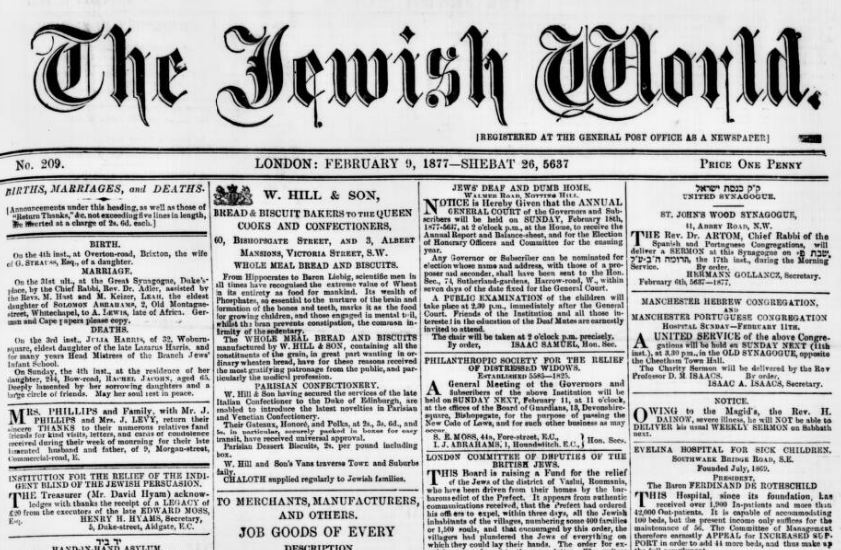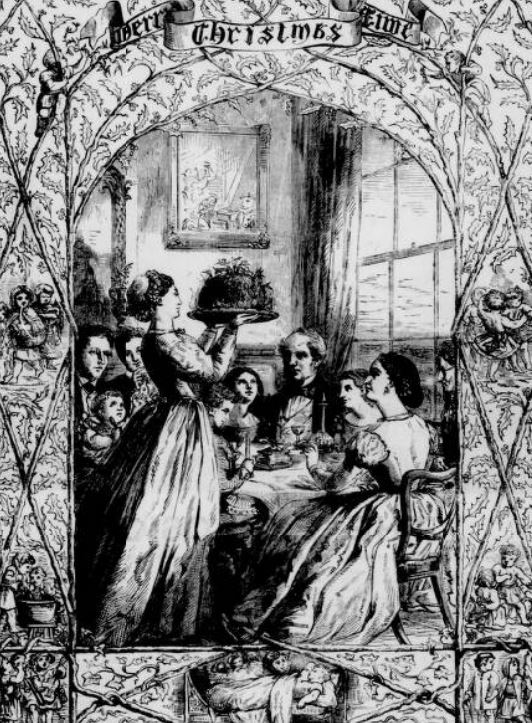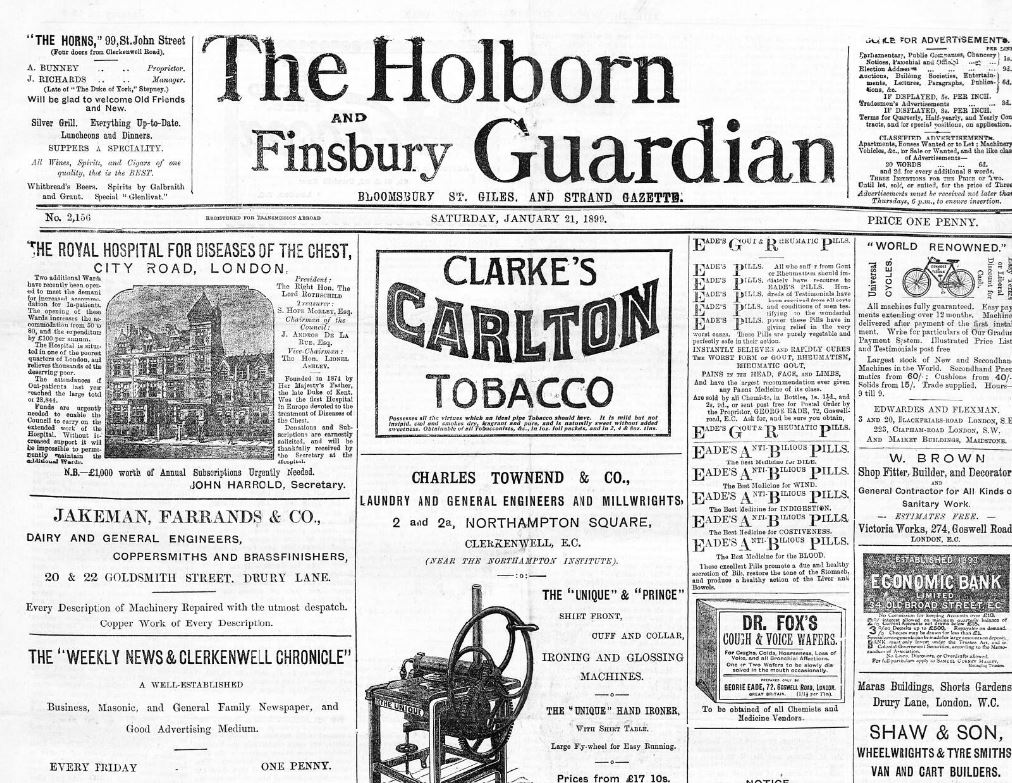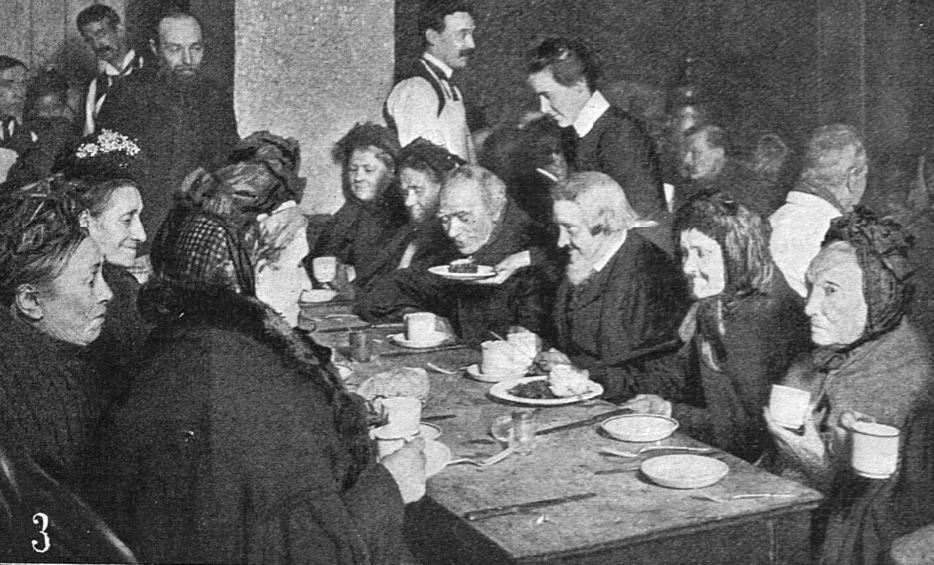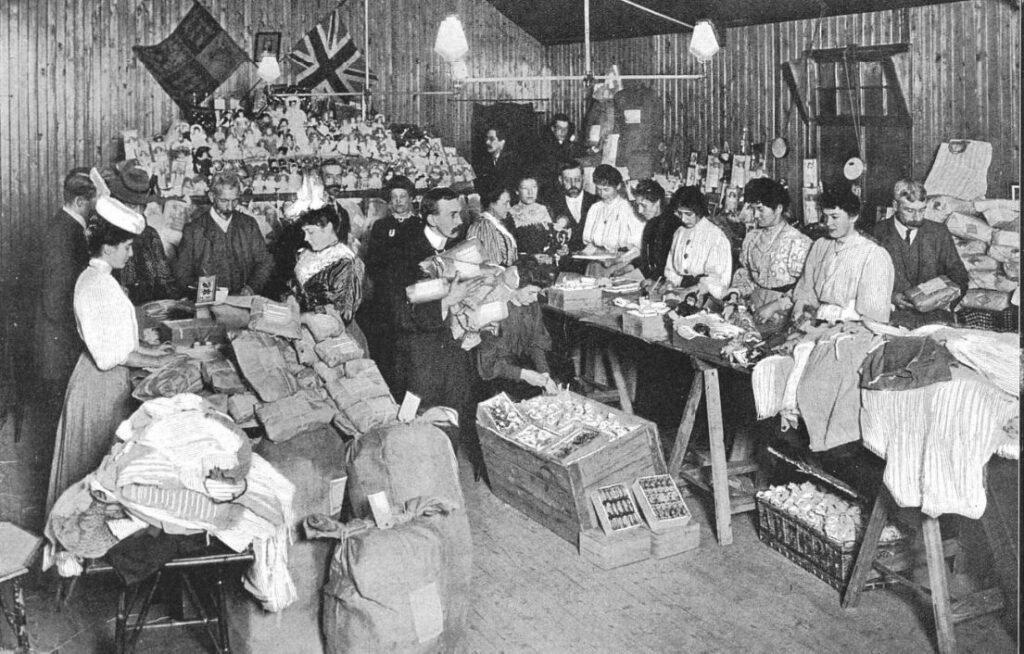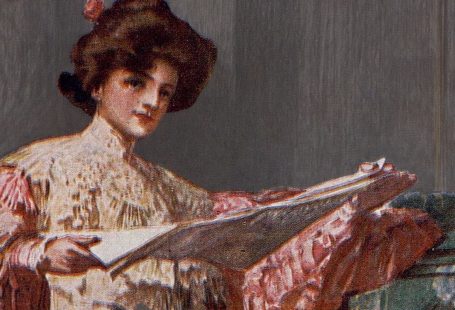With less than a week to go until Christmas, we have an array of Christmas treats with which to spoil you, as we have added 599,426 brand new pages and 19 brand new newspaper titles to The Archive over the past seven days. Meanwhile, we’ve also reached 61 million pages in total on the site, a remarkable achievement to round off what has been a remarkable year for us.
So read on to discover more about our new titles of the week, which hail from Ireland, Scotland, Wales and England, and feature some special religious and financial publications. From Lanark to Leicester, from Dublin to Derby, from Gwent to Gloucester, we’ve also listed all of the 152 titles to which we have added new pages this week. Furthemore, you can find out all about Christmastime in London in the early twentieth century, and how it was celebrated in workhouses, hospitals and churches across the capital.
Register now and explore the Archive
But we begin this week by marking Hanukah, the Jewish festival that begun yesterday evening, with the addition of a new Jewish title to our collection, which is the Jewish World. Jewish World was established in 1873 in London, as ‘an organ of intelligence for the English-speaking Jewish communities throughout the world.’
Founded by financial journalist George Lewis Lyon (1828-1904), with the title’s first editor being Myer Davis (1830-1912), Jewish World appeared every Friday and filled eight pages. Politically Liberal, the Encyclopaedia Judaica notes how the newspaper ‘filled a position of some importance in Anglo-Jewish life, publishing articles by various Zionist leaders, as well as by non-Jewish precursors of Zionism such as Henry Wentworth Monk, and Holman Hunt, the painter.’
With the first and second pages of the Jewish World dedicated to advertisements, the newspaper contained a range of special interest pieces, on topics such as ‘The Jews in Moldavia’ and ‘Ancient Versions and Manuscripts.’ The title reported on news from various Jewish communities, from Romania to Dublin, as well as containing the latest from the London Jewish community, with a list of ‘Meetings for the Week’ and the latest from the Borough Jewish Schools, the Jewish Workingmen’s Club and the Sabbath Meals Society.
Meanwhile, the Jewish World reported extensively on the activities of the Anglo-Jewish Association, an organisation that was established in 1871 to represent views on matters relevant to Jews and also to promote education through a network of Jewish schools across Britain and beyond. The association (known as the AJA) is still running to this day. For a while, the newspaper printed a Yiddish supplement.
In 1913 the Jewish World was taken over by the Jewish Chronicle, with which it finally merged in 1934.
Our second specialist title of the week is the Financial Standard, which began life in 1890 as the Financial Standard and Mining Guardian. Published in London, this title embraced ‘all departments of trade, shipping, insurance, and finance,’ providing ‘the latest authentic intelligence, treated by the foremost writers in a racy and popular style.’
With the motto of ‘Without Fear, With Reproach,’ the Financial Standard appeared ever Saturday at the cost of one penny. Filling four pages, the newspaper addressed financial matters, such as investments and insurance, as well as looking at ‘Mining Matters’ and reporting from a range of ‘Company Meetings.’ However, the main body of the publication was devoted to the ‘Latest Prices and Markets’ in Liverpool, Newcastle, Manchester, Leeds, Glasgow, Bristol, Birmingham and London, these lists filling at least half of the newspaper.
From finance to advertising now, and we hop across the Irish Sea to introduce you to the first of our two new Irish titles of the week, which is the Dublin Advertising Gazette. Founded in the 1850s as initially an advertising sheet, this title appeared every Wednesday and filled four pages. Distributed ‘gratis,’ the Dublin Advertising Gazette described itself as ‘a most eligible medium for all kinds of Advertisements, circulating 14,000 copies in Dublin and suburbs, of which 11,000 are afterwards transmitted by post and mail throughout the Irish provinces.’
Containing advertisements for a range of products and services, from perambulators to houses, from musical instruments to carriages, from furniture to confectionary, the Dublin Advertising Gazette also published serialised fiction, tide timetables, and a guide to ‘Public Amusements.’ Meanwhile, the publication took a look at commercial matters, reporting on the latest ‘Commercial Intelligence’ from Dublin, as well as reviews of the British Corn Trade. By the 1860s the Dublin Advertising Gazette had begun to include drawings, such as this depiction of a Christmas dinner scene.
Remaining in Dublin now, and we are delighted to introduce the Dublin Sporting News to both our collections of Irish and sporting newspapers. First published in the late 1880s, a new series of the Dublin Sporting News appeared on 5 February 1889, which included the below announcement:
We resume publication of what was before highly appreciated by all sections of the sporting community in this city and its suburbs, and while determined to provide all the valuable features that distinguished the former series of the SPORTING NEWS, have arranged for a supply of services for the present one which cannot fail to render it indispensable to all who are in interested in the Turf.
The announcement continued:
Briefly stated, the lines which will be followed are – Complete Programmes of all Meetings in the United Kingdom on the day they take place, Latest Arrivals and Scratchings, Morning Gallops, and Final Selections from the various courses, Special Correspondents of undoubted ability and possessed of the best possible facilities for obtaining information.
The Dublin Sporting News, therefore, would be devoted to all racing matters, and it was set to be published ‘on the mornings of all race days sharp at 10.30.’ Indeed, it referred to itself as ‘the Backer’s Friend,’ the publication’s devotion to racing clear from its illustrated masthead.
Filling four pages, and costing two pence, the Dublin Sporting News printed a detailed section entitled ‘To-Day’s Programme,’ which contained a list of all the races to be run that day, with the times, the names of the horses, the jockeys, and the owners, and even the horses’ ages being given. The publication offered its opinion on the favourites for various races, whilst looking ahead to races to come, and commenting on the London betting scene.
We travel back across the Irish Sea now to Scotland to introduce our next new title of the week, which is the Wishaw World. A weekly freesheet tabloid, the Wishaw World was established in 1982 as a companion to the Wishaw Press. Serving the North Lanarkshire town of Wishaw, which is situated near Motherwell, this title appeared every Friday until September 2011.
From Wishaw to Wales now, and we’re excited to welcome Cardiff based title Wales on Sunday to our collection of Welsh newspapers. With the by-line of ‘Winning with Wales,’ this Sunday tabloid newspaper was founded in 1989 as the sister paper of the Western Mail and the South Wales Echo. Sold throughout Wales, as well as in the bordering districts of England and in the city of Birmingham, Wales on Sunday consists of three different editions, one for North and Mid-Wales, one for South Wales, and another for West Wales. A fourth edition, for Gwent, was discontinued in 2008; however Wales on Sunday is published to this day.
The remainder of our new titles this week all hail from England, and we begin our tour of these titles in Manchester with the Manchester Evening Chronicle. The Manchester Evening Chronicle was established by newspaper proprietor, racehorse owner and Manchester City chairman Sir Edward Hulton (1869-1925) in 1897, the newspaper appearing every day, bar Sundays. Hulton also founded the Daily Dispatch in 1900 and the Daily Sketch in 1909, his father, also named Edward, having founded the Sporting Chronicle in 1871 and the Athletic News in 1875.
When Hulton retired in 1923, his newspapers were sold for £6 million, and were subsequently controlled by publishing giants Lord Beaverbrook and Lord Rothermere. In 1944 the newspaper was renamed, becoming simply the Evening Chronicle, before it was merged with its more successful rival the Manchester Evening News in 1963.
Our next stop is the Wirral, and the Hoylake & West Kirby News. This title traces its origins back to the Wirral News, which was founded in 1877 as the Birkenhead News and Wirral General Advertiser. The Wirral News produced several different editions, such as the Wallasey News and the Bebington News, with the Hoylake & West Kirby News arriving on the scene in 1976. In 1984 these titles were all united under the Wirral News, but were split up again in 1989, to be re-amalgamated once again in 2008.
We travel to Lincolnshire now to welcome our next two new titles of the week, beginning with the Axholme Herald. Established in 1989 in Epworth, a market town in north Lincolnshire which lies in the Isle of Axholme, the Axholme Herald appeared every Thursday with the by-line of ‘The Isle is My Parish.’ Indeed, the Isle of Axholme was once an inland island surrounded by rivers, streams and bogs until the area was drained by Dutch engineer Sir Cornelius Vermuyden in 1627-1629.
Our second new Lincolnshire title of the week is the Louth Target, which was founded in 1990 as a sister paper to the Lincolnshire Echo. The Louth Target formed one part of the two part Wolds Target series, the other title being the Horncastle Target. Delivered to homes in the towns of Louth, Horncastle, Woodhall Spa, and Coningsby, the Louth Target appeared every Wednesday.
Published in the market town of Louth, in East Lindsey, an important town in a rural part of east Lincolnshire, in 2008 the Louth Target absorbed the Market Rasen Target. In 2011 the title then absorbed the Horncastle Target to become the Louth and Wolds Target, its final edition appearing in September 2012 as it merged with the East Coast Target to form the East Lindsey Target.
We are now over halfway in our journey through our new titles of the week, and our next stop is Ely and the Ely Weekly News. Evolving from the Ely Town Crier, which began in 1987, this publication became known as the Ely Weekly News & Town Crier in 1997, and finally the Ely Weekly News in 2000.
Serving the cathedral city of Ely and the surrounding parts of the Isle of Ely in northern Cambridgeshire, the Ely Weekly News also circulated in the towns of Littleport, Sutton, Little Downham, Stretham, Witchford and Soham. The final edition of this newspaper, which appeared every Thursday, was published on 1 October 2017.
It’s to London that we travel now, and our next seven new titles this week all hail from the nation’s capital. And we begin with the Brondesbury, Cricklewood & Willesden Green Advertiser, which was first published on 18 March 1892 from the High Road, Kilburn, in north west London. Issued in ‘connection with the St John’s Wood, Kilburn and South Hampstead Advertiser,’ this title was set to be ‘carefully circulated to the householders in the districts of Brondesbury, Cricklewood, and Willesden Green,’ offering ‘chatty news of the neighbourhood,’ as well as ‘reports of public meetings, concerts, socials,’ and news from ‘churches, chapels and institutions.’
Appearing every Friday, and filling four pages, the Brondesbury, Cricklewood & Willesden Green Advertiser was entirely focussed on local issues. Featuring local news from the likes of the Brondesbury Baptist Church, the Willesden Local Board, and the West Hampstead Mutual Building Society, the publication also featured drawings, the first edition containing one of the United Synagogue at West Hampstead. With a guaranteed circulation of 3,500, the newspaper took a look too at the ‘Health of Willesden’ and featured a list of preachers for the coming Sunday.
We’re going to stay in north west London now to introduce the Wembley Observer to our collection. This title was a weekly freesheet tabloid newspaper delivered to homes across the London Borough of Brent, incorporating Sudbury, Alperton, Perivale, Greenford, Wembley, Neasden, Cricklewood, Harlesden, and Willesden. Part of the Harrow Observer series of newspapers, the Wembley Observer was named in the masthead of 1895 newspaper the Wealdstone, Harrow & Wembley Observer, appearing as a separate title in 1946 under the name of the Wembley Observer and Gazette.
The Gazette part of the Wembley Observer was subsequently dropped in 1965. Appearing every Thursday, in 2010 the title merged with the Willesden Observer to become the Wembley & Willesden Observer. Within a year, however, the title was back to being the Wembley Observer.
The final of our trio of new West London titles this week is the Middlesex Mercury, or to give it its full title, the Middlesex Mercury and County-Town Brentford Chronicle with which is incorporated the Hounslow and Brentford Independent. Established in Isleworth in 1870, this lively and informative newspaper appeared every Saturday at the cost of just one penny.
Filling eight pages, the Middlesex Mercury contained local, national and international news, with short paragraphs of news giving the newspaper a dynamic feel. Addressing local matters, the Middlesex Mercury printed the latest from Hounslow, Ealing, Heston and Brentford, whilst featuring letters to the editor and details of recent wills and bequests. The newspaper also published a variety of special interest columns, from ‘Scientific Notes’ to ‘Gardening Work for the Week.’
We’re in central London now to introduce the St. Pancras Chronicle, People’s Advertiser, Sale and Exchange Gazette to our collection. Founded in 1899, the St. Pancras Chronicle circulated in ‘St. Pancras, Marylebone, Hampstead, Highgate, Islington, and the surrounding districts.’ Costing just one halfpenny, this quirky newspaper appeared every Friday, and filled eight pages.
Taking a look at local matters, the St. Pancras Chronicle reported on the items that came before the local ‘Coroner and Jury,’ such as strange and unexpected deaths, as well as on the latest from the police courts of Marylebone, North London and Clerkenwell. It also detailed the news from the likes of the Somers Town Presbyterian Church, the North St. Pancras Ratepayers Association, and the St. Pancras Licensed Victuallers Charitable Institutions Association.
As well as reporting on national and international news, the St. Pancras Chronicle reported on local weddings in a section entitled ‘Wedding Bells,’ on sports like football and athletics, on what was on at the London theatres, and finally, it featured a column called ‘Historic St. Pancras,’ which took a look at the history of the area.
Published not too far away from the St. Pancras Chronicle was the Holborn and Finsbury Guardian, which was established in 1869. ‘The only official organ of the important districts of Holborn, Bloomsbury, St. Giles, St. Luke’s, Clerkenwell, and the Strand Union,’ the Holborn and Finsbury Gazette gave ‘all [the] local news’ from this area of central London, appearing every Saturday at the cost of one penny.
Independent in its politics, this newspaper was almost entirely focussed on local events. Its eight pages covered news from the Clerkenwell Vestry, from St. Giles’s Boys’ School, from St. Luke’s Vestry, as well as looking at successful local ‘business enterprises,’ such as Mr. C.F. Brust’s Amwell Street bakery, and local inquests. The Holborn and Finsbury Guardian also featured serialised fiction, a look at the latest fashions, and contained hints and tips for household management.
Our penultimate new London title hails from the east of the city and is the Eastern Mercury, which was first published in the early 1890s as the Eastern Mercury and Leyton, Leytonstone, Woodford and Chingford Post. This lively and informative newspaper appeared every Tuesday at the cost of one halfpenny, its eight pages filled with local, national and international news.
For example, within the pages of the Eastern Mercury you could read the latest news from Leyton, Wanstead, Forest Gate, Ilford, Manor Park, West Ham, Loughton and Leytonstone, as well as perusing serialised fiction, football notes, and ‘views of the weekly press.’
Our final new London title of the week, and our penultimate one overall, is the Croydon Post, which was founded in 1967 as the Croydon Midweek. Appearing every Wednesday, from 1972 to 1985 the title was known as the Croydon Midweek Post, becoming after that simply the Croydon Post. A companion newspaper to the Croydon Advertiser, the Croydon Post was a weekly freesheet tabloid newspaper that was distributed to homes across the London Borough of Croydon. This title ceased publication in May 2010, and was replaced by the Advertiser Midweek.
For our final new newspaper title of the week we travel to Devon, to the port town and seaside resort of Exmouth. And we’re delighted to introduce the Exmouth Chronicle to our collection, a Liberal title that was founded in 1881. A ‘Weekly Journal for Exmouth, Budleigh Salterton, Lympstone, Woodbury and District,’ the Exmouth Chronicle appeared every Saturday, costing just one penny. A thoroughly local newspaper, the title reported on local issues such as trade disputes in Exmouth, Exmouth rugby matches, Exmouth fancy dress balls, and Exmouth whist drives. The Exmouth Chronicle also printed notices of births, marriages and deaths.
What a bumper crop of newspapers for you this festive season! And the treats do not stop there, as we’ve added brand new pages to 152 of our existing titles. Highlights include the over 31,000 brand new pages we’ve added to the Gateshead Post, whilst we’ve also updated one of our Isle of Man newspapers, the Isle of Man Daily Times.
Meanwhile, we’ve updated some of our Irish titles, such as the Irish Independent and the Evening Herald (Dublin), with updates also to our Scottish titles, like the East Kilbride World and the Blairgowrie Advertiser. Finally, we’ve added new pages to a range of our Welsh newspapers, with updates to titles including the North Wales Weekly News, the Gwent Gazette, and the Holyhead Mail & Anglesey Gazette.
Christmas Celebrations in 1907
With Christmas only a few days away we thought we’d delve into the pages of our new newspapers and discover how Christmas was celebrated in days gone by. And our new newspaper the St. Pancras Chronicle, People’s Advertiser, Sale and Exchange Gazette did not disappoint, as it detailed ‘Christmas in St. Pancras‘ on 27 December 1907.
The article in the St. Pancras Gazette begins by noting how Christmas in 1907 ‘might be called a quiet Christmas.’ The newspaper speculates that this quietness at Christmastime may have been due to ‘the hardness of the times, or to the improved habits of the people.’ Indeed, the article leans to the latter cause, outlining how:
There was very little of that rowdyism in the streets, that boisterous conduct which passes current for rejoicing. This fact gives some people ‘furiously to think’ that Christmas as a festival is decaying, but the attendance at the churches and chapels does not bear this out. We think that the people are becoming more sober as the years go by, and this has been noticeable for the past eight or ten years.
Moving on from such pontification, the St. Pancras Chronicle then takes a look at how Christmas was celebrated in the newspaper’s local area, describing how ‘there was rejoicing and plenty of it.’ Indeed, the article focuses on the Christmas celebrations amongst those who were less well off, for example describing the festivities at the St. Pancras Workhouse, and at the Highgate Infirmary.
So how did those 2,000 ‘inmates’ at St. Pancras Workhouse celebrate the season? The St. Pancras Chronicle reports how the ‘wards were made bright and cheerful’ by the nurses and the officers, who were also assisted by the inmates, ‘many of whom [were] possessed of high artistic tastes.’ Those in the workhouse were then served a Christmas dinner, which consisted of the below foods and quantities:
Plum pudding 1lb, Pork ½ lb, Parsnips ½ lb, Potatoes 2 lbs. This substantial fare was supplemented by oranges and fruits of different kinds, and the men got 1 oz of tobacco each, with a pipe, so that during the day there was a very cloudy atmosphere of the day rooms in the workhouse. The old ladies too got an allowance of snuff.
From the workhouse to one of the local hospitals, Highgate Infirmary, where ‘the officers were also busy making the poor patients feel ‘the one touch of nature.’’ Holly and mistletoe were brought in to decorate the sick wards, and the patients here also had their own Christmas dinner. The St. Pancras Chronicle notes how ‘the fare was such that, under the wise guidance of the medical officer, each patient might enjoy without any detriment to health.’

At the University College Hospital the St. Pancras Chronicle tells us that the ‘wards were decorated by the nursing staff, assisted by the medical students attached to each ward.’ 280 patients took part in the festivities, including 36 children, and each received a gift. The patients, like those at Highgate Infirmary, were given a ‘special dinner, consisting of turkey and Christmas pudding,’ and the celebrations were rounded off by some carol singing.
Meanwhile, the Christian Men’s Gospel Mission, ‘whose work in Somers Town has gone on for 45 years,’ provided a Christmas dinner to ‘about 600 children,’ aged from three to fourteen-years-old. Christmastime was a time to give back to the community, to those less fortunate, the St. Pancras Gazette noting how:
The poor in their own homes, too, had substantial presents of beef, pork, and mutton, so they should not be without a Christmas dinner, and many of them were supplied with blankets and warm clothing.
Finally, the newspaper addressed the Christmas attendance at the local churches, describing how they were ‘filled with devout congregations.’ Indeed, the St. Pancras Chronicle reported that ‘in every church in St. Pancras there was a marked increase in attendance,’ with St. Paul’s at Camden Square raising money for the St. Pancras Female Orphanage in Hampstead Road.
Christmas in 1907 represented a time for charity, and was celebrated in familiar ways, ways in which we still celebrate today – with carols, decorations, and Christmas dinners featuring turkey and Christmas puddings. Find out more about how Christmas was celebrated in days gone by here.
New Titles
| Title | Years Added |
| Axholme Herald | 1992, 1998 |
| Brondesbury, Cricklewood & Willesden Green Advertiser | 1892 |
| Croydon Post | 1995-1996 |
| Dublin Advertising Gazette | 1858-1877 |
| Dublin Sporting News | 1889-1893 |
| Eastern Mercury | 1892, 1895, 1904, 1907, 1911 |
| Ely Weekly News | 1997-1999 |
| Exmouth Chronicle | 1920 |
| Financial Standard | 1891 |
| Holborn and Finsbury Guardian | 1899, 1901, 1904, 1910, 1913 |
| Hoylake & West Kirby News | 1998 |
| Jewish World | 1877, 1889, 1898 |
| Louth Target | 1997-1999 |
| Manchester Evening Chronicle | 1914, 1916 |
| Middlesex Mercury | 1895 |
| St. Pancras Chronicle, People’s Advertiser, Sale and Exchange Gazette | 1907 |
| Wales on Sunday | 1992 |
| Wembley Observer | 1997 |
| Wishaw World | 1990 |
Updated Titles
This week we have updated 152 of our existing titles.
You can learn more about each of the titles we add to every week by clicking on their names. On each paper’s title page, you can read a FREE sample issue, learn more about our current holdings, and our plans for digitisation.
You can keep up to date with all the latest additions by visiting the recently added page. You can even look ahead to see what we’re going to add tomorrow.


